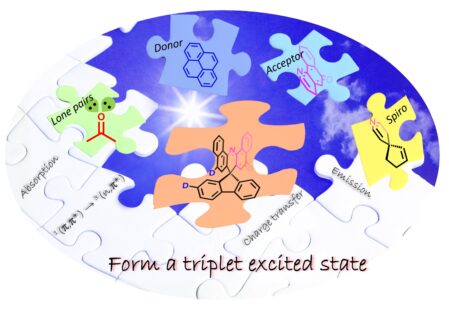Again paper in Angewandte published
Tuning the Absorption, Fluorescence, Intramolecular Charge Transfer, and Intersystem Crossing in Spiro[fluorene]acridinone
Researchers from Friedrich-Alexander-University of Erlangen-Nuremberg (FAU) and the Nanjing University of Posts and Telecommunications provide important guidance for designing novel functional materials for triplet sensitizers and fluorescent sensors.
Intersystem crossing is a significant photophysical process in organic molecular systems on the way to create a triplet excited state, which is the cornerstone of photo-catalysis, photo-upconversion, oxygen sensing, and photodynamic therapy, etc. However, it is challenging to design molecules that promote the development of triplets, so called triplet sensitizers, with predetermined intersystem crossing properties – especially for compact organic molecules without heavy atoms – as slight structural modifications can easily alter the photophysical properties. Therefore, understanding the structure-property relationship of light-driven pathways requires systematic and in-depth investigations and is expected to facilitate the rational design of new materials and optimize various applications.
In this project, we investigated a series of donor-acceptor dyes based on spiro compounds, based on a fluorene and an aromatic ketone, which can easily be synthesized and functionalized at different sites. By introducing an electron-donating pyrene moiety at either the fluorene or the aromatic ketone, absorption and fluorescence can be tuned, and subsequent steps like charge transfer process and intersystem crossing can be controlled. The map of excited state dynamics of designed dyes in different solvents is systematically built through a combination of steady-state and time-resolved absorption and emission spectroscopies in order to reveal the complex interplay between different excited state decay pathways.
These findings were published in the Angewandte Chemie International Edition under the title “Tuning the Absorption, Fluorescence, Intramolecular Charge Transfer, and Intersystem Crossing in Spiro[fluorene]acridinone” (10.1002/anie.202313936). In general, the understanding of the structure-property relationship of light-driven pathways is the basis for designing and fine-tuning materials and technologies that depend on interactions between light and matter. Therefore, this work opens new strategies for the rational systematic design of novel organic materials for fluorescent sensors and heavy-atom-free triplet sensitizers.
Contact:
Prof. Dr. Dirk Guldi
